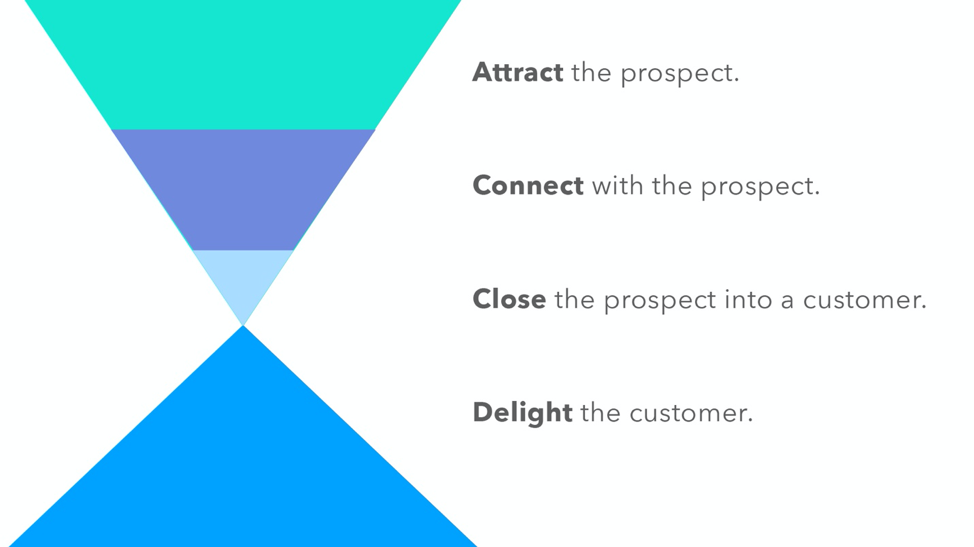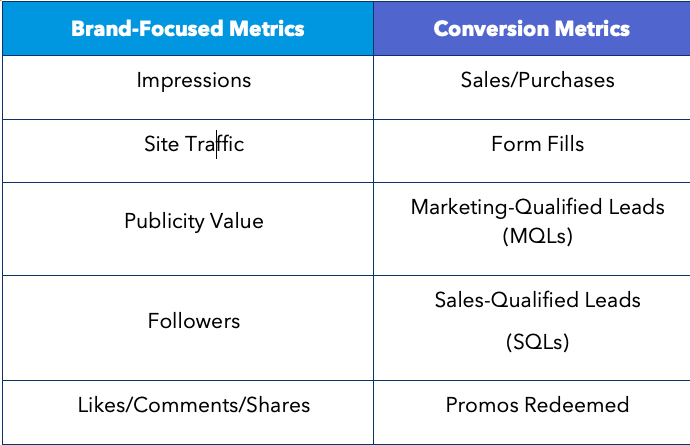
The 11 Principles of Purposeful Marketing
By Austin LaRoche, ATAK Interactive CEO
“A man gotta have a code.” – Omar Little
The Purposeful Marketing Method is a three-part framework. It is an easy-to-adopt system that small to mid-enterprise businesses can use for pragmatic growth. It is built on 11 principles that guide customers through exercises and processes that increase efficiency and profitability.
As you will read below, the idea of businesses and customers having shared beliefs is one of the most important parts of any fruitful relationship. After seeing what’s been successful in my decade-plus experience in marketing for SMBs, these are the beliefs that I hold about marketing in 2019. They touch on the brand, audience, data, and marketing-to-sales operations of a company and are based on real experience and real results.
Without further ado, here are the 11 Principles of Purposeful Marketing:
1) Your Brand, Data, Audience, and Marketing-to-Sales Operation must be aligned.
What does it mean to be aligned? Let’s go to the basic definition:
a·lign·ment
/əˈlīnmənt/
noun
a position of agreement or alliance.
If your brand is projecting messages and visuals that have a distinct point of view, you are simplifying your data by focusing only on the most important metrics, you are segmenting your messaging to the right audience, and you’re executing actions specific to your marketing-to-sales operation, you have alignment.
Most businesses do not have that alignment, unfortunately. Brands lack clarity in messaging, have their data spread all over the place, they try to speak to everyone and be everything they can be to them, and market for awareness and impressions more than they do lead generation, sales, and growth.
This isn’t because they wish to have things all over the place. There’s a ton of noise out there and people get distracted by the “latest and greatest.” That’s why establishing a foundation of alignment is so important.
Here’s an overview of what alignment looks like:
Brand:
- Everyone in the company knows why you do what you do, how you do it, and what it is you do.
- They understand the three differentiators that make you unique and how those provide value to your customers.
- All of your visuals have this clarity as well and represent the why-how-what you defined previously.
- There’s a visualization of your proven process that showcases your ability, credibility, and flexibility.
- You have a message to attract your customers that makes them the hero and creates a leading message in your industry.
Data:
- You can calculate your current data as it relates to budget, goals, and results.
- The Most Important Metrics (MIMs) to your company’s growth are identified and tracked.
- The S.M.A.R.T. goals needed for each of those MIMs to hit their targets is clear.
- The current budget and resources are allocated clearly and concisely in a way where the whole organization knows why you’re spending money on each initiative and what you expect in return for that investment.
Audience
- You know what your shared beliefs are with your customer. You’re not afraid to ignore those who do not share these beliefs.
- You have fully defined the different segments which you will market as your Target Personas and identified the desires, challenges, and tendencies for each.
- You know specifically how you can help each Persona and can avoid any prospect you cannot help.
Marketing-to-Sales
- Your marketing initiatives are tied directly to each step of the customer lifecycle:
- Attract the prospect
- Connecting with the prospect
- Closing the prospect into a customer
- Delighting the customer
- Each of your target personas are being specifically marketed to
2) Every action taken and every dollar spent must have a purpose within the Customer Lifecycle
If there’s one thing we often see in marketing, it’s that the creatives involved can rarely agree on terminology. Even entities like HubSpot, which frequently make up terms like “The Buyer’s Journey,” consistently change how they define each step.
In the Purposeful Marketing Method, we aim to simplify things. We identify the Customer Lifecycle as:

Everything we recommend a business invest in feeds one of those four stages of the Lifecycle. If a company is doing something just to do it without any reason or purpose, we take it away. If you’re chasing BS data like impressions so you can show something big and shiny to your boss, we tell you why it’s not important.
This is what marketing should look like – a never-ending continuum of work that supports these four functions. Within each, specific measurables get defined, a single person becomes responsible for the outcome, and the appropriate budget goes towards each.
3) Quality is 360 Degrees
In Phil M. Jones’ “How to Persuade and Get Paid” Sales Workshop, he talks about the importance of creating a good representation of yourself and your company. He uses a vivid example from his life before sales when he almost made a bad purchase from a company that couldn’t fulfill its promise and how he sniffed it out because of the pen he was about to use to sign a contract.
Here he was, ready to give this salesperson their deal, and as he took the pen, he realized something – it had been chewed. He began looking over the salesman a little further – dissecting his clothes and manners before deciding he wanted a little more time to think it over.
The salesperson lost the deal because it was clear that his pitch was a mirage. He wasn’t what he said he was.
We see something similar a lot in marketing. A company boasts of its commitment to quality, even outlines the features that make their product or service the best, but they do so with a poor design that gets translated to an outdated website or flimsy marketing material.
If you are asking a customer to invest in quality, you need to make it clear that you do, too. Every aspect of your marketing needs to be as pristine as your promise. If you’re an industry leader, you better dress like, talk like it, and look like it. Otherwise, you’re going to be looked at like a chewed pen.
4) Your Customer is Luke Skywalker, you are Yoda
Nancy Duarte is the first to use this analogy for marketing. An expert in the presentations space, Duarte teaches her students the concept that as the presenter, you are being looked at as Yoda. Everyone in the audience thinks they are the hero, Luke. Your job is to show them how all of their dreams can come true with your guidance.
Author Donald Miller took this concept to the next level with his book, “StoryBrand,” drawing an even more distinct parallel between the analogy of the hero/guide and tying it into a traditional film narrative.
He writes:
“Here is nearly every story you see or hear in a nutshell: A CHARACTER who wants something encounters a PROBLEM before they can get it. At the peak of their despair, a GUIDE steps into their lives, gives them a PLAN, and CALLS THEM TO ACTION. That action helps them avoid FAILURE and ends in SUCCESS.”
Purposeful Marketing shares these viewpoints. We believe that taglines particularly should make it clear how a company as a guide helps take the hero to the Promised Land.
Through other marketing materials, we look at the stakes, the vision for success, and showcases the transformation this hero would have if he/she were to let us guide them.
To steal one more quote from Miller, “In every line of copy we write, we’re either serving the customer’s story or descending into confusion; we’re either making music or making noise.”
Amen.
5) Lead. Always Lead.
“The Future of Marketing is Leadership.” – Seth Godin
In early 2019, Edelman, the global PR firm, released their B2B Thought Leadership Impact Study. Among the eye-popping stats that came from the report was that “58% of B2B decision-makers made buying decisions based on thought leadership.”
The study had four main takeaways on Thought Leadership:
- There’s currently a deficiency in the marketplace because B2B marketers and sales teams are underrating its impact
- Decision-makers will spend more to work with leaders
- Decision-makers are hungry and interested in more thought leadership
- You need to put in the elbow grease to make sure your leading message is actually unique, knowledgeable, and persuasive
It’s clear that thought leadership is a great way for companies to stand out.
With trends like influencer marketing showing its warts, it’s important for businesses to understand that real purchasing influence, particularly in the B2B space, comes from prospects feeling comfortable being led into a new direction by someone they trust. Remember, as their guide, they are looking at you to lead them.
Showcasing thought leadership in the Attract phase is a great way to illustrate your ability to be a prospect’s guide from your initial interaction. Businesses just meeting prospects for the first time have to get over a credibility hump. By illustrating a unique perspective, proving your knowledge in the field, and persuading your prospect to take action, you can ease a customer’s hesitations rather quickly.
6) If somebody doesn’t hate you, nobody will love you
One of the major transitions we’re going to see in the 2020s is a shift away from the lantern and towards the laser. The job of a lantern is to emit as much light as possible. The job of the laser is to pinpoint exactly where the light needs to go.
Marketing strategies for decades have focused on the mass market. Whether its commercials/billboards or simply social media following, the idea of thinking big was always applauded.
But with the evaporation of the monoculture, mass markets are far less effective. The world has been taken over by the Long Tail. Over 75 million people watched the Seinfeld series finale in 1998. 21 years later, the most popular series of its decade, Game of Thrones, had just 19.3 million viewers. We are not all tuned in to the same TV, music, or cultures because so many exciting avenues now exist.
This shift into a Mass Long Tail of Subcultures challenges businesses to build brands that resonate with smaller viable audiences. Companies need to market more like a laser and less like a lantern.
To achieve this connection with the less populated subcultures, brands are going to have to start building tension with their messaging. This doesn’t mean taking any drastic political stance or purposely alienating good paying customers. Rather, it’s looking through the lens of “people like us, do this” to talk to our prospects and customers.
Many companies are terrified of this. The idea that they can’t be everything for everybody seems so…limiting. But this is a sliding doors moment for companies. They can do the status quo in Door #1 and continue to play it safe and they will absolutely avoid the haters. Unfortunately, no one will love them because they’re not speaking with enough substance to elicit that passion. Behind Door #2, they will find the courage to adopt the laser and begin narrowing their message to that smaller viable audience. They will find more people turned off than ever before, but they will earn true evangelists who will recruit others to join their cause.
This takes courage, but now is the time to step up. For instance, at my company, ATAK Interactive, we’ve adopted a little motto for ourselves: we’re the marketing agency that hates marketing. We know every trick in the book that agencies use to project their value, the metrics they fall back on when the work isn’t meeting the goals, and the ready-made excuses in their back pocket when things fail. We want our work to support growth, support sales, support the company leaders. And we’re not afraid to say things like “much of inbound marketing is a well-intended mirage.” If 200 other HubSpot agency partners hate us, that’s fantastic. It just means all the companies they couldn’t land an ROI for will love us a little more for speaking out against idealism posed as a marketing strategy.
7) There’s a lot of great customers that are not YOUR customer.
One of the hardest concepts of Purposeful Marketing for business owners to grasp is the idea of “breaking up” with a customer type. Just like messaging has been focused more towards the lantern in the past, defining a target market has as well.
There’s a big difference between “breaking up” in the prospecting stage vs. the client stage. It would be foolish for any company to break a long-standing relationship with a top client because they read some hotshot marketer talking about it. But much like companies need to hone-in on a message that resonates with a smaller target market, they need to accept that this means there will be a LOT of great customers that are not OUR great customer. And that’s okay.
We can recognize that varying industries, psychographics, and business practices can make a great customer a competitor’s great customer. We can admit that companies that specialize in certain areas may be better than us.
Let’s use a contractor as an example.
This contractor, we’ll call him Hank (strong contractor name, btw!), has 20 years of experience working effectively on Craftsman-style homes. His mother, Alberta, needs a kitchen remodel in her Spanish Colonials. Obviously, Hank has the experience to complete the job, but probably not as well as someone who has specialized in the Spanish style. So if money isn’t an issue, and Hank just wants his mother to get the best service possible, there’s no doubt he’d recommend the right contractor for her, right?
Additionally, if he did Mr. “I Specialize in Spanish Colonials” a favor, there’s a good chance that would be repaid down the road when the shoe was on the other foot.
The best barometer you can use is “who can I help better than almost everybody else?” This is your great customer. “Who can I help, but not as good as (insert competitor)? That’s the great customer who is not yours. Make sure to know the difference.
8) All metrics that matter feed some sort of conversion
Take a look at the chart below:

As you can see, we segment the different brand-focused metrics that companies track vs. the conversion-based metrics.
A lot of the brand-focused metrics make companies feel good. When their PR team lands a story on the news and they see a bloated $3.1 million in publicity value data point, they feel like the media relations ROI is strong. When they get 1,000 comments on an Instagram post, they feel even better. People are ENGAGING with us!
But what do those numbers mean if they can’t be traced to the conversion metrics? Sure, not every lead and/or deal will be able to be tracked to each event in a marketing campaign. But businesses need to know how these brand metrics affect the conversion metrics.
For every _____ amount of site visitors, we get ______ amount of form fills. For every _____ amount of form fills, we get ______ amount of Marketing Qualified Leads (MQLs). And for every ______ amount of MQLs, we get ______ amount of customers.
Because in a vacuum, site traffic doesn’t matter. I can buy you a couple of thousand visitors from a third world country tomorrow if you want to feel good about your volume. But traffic does matter when you understand where it fits into the formula. Building, measuring, and optimizing that formula is the only way you can keep your brand metrics accountable and have them feed directly to your conversion metrics.
Making data work for your company goes beyond tracking it. Anyone can track numbers. You must track the purpose of each activity, and identify how it affects the overall success of a campaign.
9) Data must be tracked in a simple way to drive behavioral change.
In over 10 years managing clients, one of the most surprising discoveries I’ve had is just how many of them hate looking through reports. My project managers would send them, ask to review, and get no response. After a while, I started diving deeper to find out why.
Every client who dismissed reports had a similar reason that can be summed up as “there are too many numbers, things I don’t care about, and it’s so long I don’t care to spend the time looking through to figure out what actually matters.”
Of course, these were generally exported, summarized, and analyzed for context. We always wanted to show how “thorough” and “robust” we could be that we were feeding our own desires and not the customer’s needs.
So we flipped it around and made two big changes:
- Instead of a monthly report, we started looking at the numbers every week.
- We narrowed it down to 7-13 interesting numbers that went well beyond what a Google Analytics export could pump out.
Instead of focusing on things like “bounce rate” and “average page session,” we put a spotlight on “B+ Leads” and “(Persona Type) Leads” to make things more relevant to the client.
What did we find?
The days of pumping out reports that nobody read or reacted to were gone. Now, we were having data-driven conversations about these metrics that mattered and making weekly decisions on how we could execute differently to achieve great results.
This is the spirit of data with Purposeful Marketing. It doesn’t mean that the robust analytics don’t matter, but rather, how we track them, review them, and most importantly, REACT to them starts from a place of simplicity.
10) Systems can be scaled, people cannot be cloned
In almost every B2B sales team I have ever worked with, there’s an archetype I refer to as the Superstar Sales Person. This ace, we’ll call he or she the SSP, is such an asset to a company, at least on paper.
The SSP has the best relationships, the happiest customers, and consistently brings in new business. Often times though, the Superstar Sales Person can lead to SSPS – Superstar Sales Person Syndrome.
When you’re the rainmaker of the sales team, and you have all the leverage, oftentimes, you play by your own set of rules. I’ve seen plenty of great salespeople who rarely touch CRM, use talking points/presentations others don’t have access to, and use their successful relationships to threaten management in negotiations. Most of the time, the SSPS is not that extreme, but it gets in the way of the company structure because the top sales performer is not the top sales LEADER.
This is why it’s so important for companies to have growth systems they can build, train, and scale, regardless of human capital. Many times, the SSP is the perfect person to help create the system (even if he or she is NOT the right person to lead the company in adopting it).
The elements of Purposeful Marketing aim to create the initial roadmap for companies to build this system, while keeping it flexible for sales teams and their superstars to adopt seamlessly.
11) All Projects Must Be Broken Down into S.M.A.R.T. Goals
SMART goals are Specific, Measurable, Achievable, Realistic, and Timely.
SMART Goals make everything manageable. Let’s say you’re planning a road trip from Jacksonville, FL to New York City. Google tells you that you’ve got 14 long hours ahead and with stops and traffic factored in, you’re probably looking more at 16 hours. You leave Florida at 5am with the hope to get to the boroughs before midnight.
As you begin the drive up I-95 you don’t see signs for New York (900 miles away!), but rather Savannah, then Fayetteville, then Richmond, then Washington DC, and so forth. You make small strides and incrementally hit checkpoints along the way.
Achieving a goal is no different. We all want to get to NYC, but there are all sorts of Richmond, Virginias we have to pass through to get there.
This is where SMART goals come into play. They help us breakdown the long road to success into necessary checkpoints we need to hit our destination.
Throughout the Purposeful Marketing Method, in each stage of the process, we MUST work with SMART goals to get from one point to the next. They keep us accountable and they keep us on the right track.
So, those are the Principles…
The principles above are the backbone of Purposeful Marketing. They are the beliefs that drive our method. They should be shared beliefs. If you read through these and recognize this approach is the guide you’ve been looking for, dive in. I’ve built this method for people like you. And for everybody else, you may just be a great customer who is not my customer. And that’s okay, too.
I’m here to help small to mid-size B2B companies grow pragmatically. If you’re ready to see how, let’s start getting focused.
Related Posts

Marketing Strategy Agency Derivatives and Growth Unlocked
Marketing is an essential aspect of any business. It can help increase brand awareness, attract new customers, and drive sales. However, developing an…

Boosting ROI: Benefits of Hiring a Marketing Strategy Agency
Are you looking for ways to enhance your marketing strategy and increase your returns? Look no further than Derivatives, a top-tier marketing strategy…

The Role of a Web Design Agency in Boosting Your Online Presence
We examine the field of web design and the work of web designers in this blog. It takes a variety of talents, including graphic design, coding, and user…